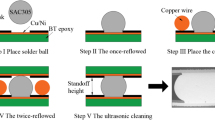Abstract
This paper evaluates the shearing behavior of ball grid array (BGA) solder joints on Au/Ni/Cu pads of FR4 substrates after multiple reflow soldering. A new Pb-free solder, Sn–3Ag–0.5Cu–8In (SACI), has been compared with Sn–3Ag–0.5Cu (SAC) and Sn–37Pb (SP) solders, in terms of fracture surfaces, shearing forces and microstructures. Three failure modes, ball cut, a combination of solder shear and solder/pad bond separation, and pad lift, are assessed for the different solders and reflow cycles. It is found that the shearing forces of the SP and SAC solder joints tend to increase slightly with an increase in the number of reflow cycles due to diffusion-induced solid solution strengthening of the bulk solder and augmentation of the shearing area. However, the shearing forces of the SACI solder joints decrease slightly after four cycles of reflow, which is ascribed to the thermal degradation of both the solder/intermetallic compound (IMC) and IMC/Ni interfaces. The SACI solder joints yield the highest strengths, whereas the SP solder joints give the smallest values, irrespective of the number of reflow cycles. Thickening of the interfacial IMC layer and coarsening of the dispersing IMC particles within the bulk solders were also observed. Nevertheless, the variation of shearing forces and IMC thickness with different numbers of reflow cycles was not so significant since the Ni under layer acted as an effective diffusion barrier. In addition, the initially-formed IMC layer retarded the further extensive dissolution of the pad material and its interaction with the solder.














Similar content being viewed by others
References
Richards BP, Levoguer CL, Hunt CP, Nimmo K, Peters S, Cusack P (1999) An analysis of the current status of lead-free soldering, (NPL, ITRI and DTI joint report about Pb-free soldering, Jan.). http://www.npl.co.uk/ei/documents/pbfreereport.pdf
Suganuma K (2003) Lead-free soldering in electronics: science, technology and environmental impact. Marcel Dekker, New York
Hwang JS (2001) Environment-friendly electronics. lead-free technology. Electrochemical Publications, New York, pp 277
Sattiraju SV, Dang B, Johnson RW, Li YL, Smith JS, Bozack MJ (2002) IEEE Trans Compon Packag Manuf Technol Part C Manuf 25:168
Connell JO (2005) Study and recommendations into using lead free printed circuit board finishes at manufacturing in circuit test stage (Agilent Technologies white paper). http://www.home.agilent.com/upload/cmc_upload/All/5989–1558EN.pdf
Toleno B (2003) PCB surface finish options for lead-free manufacturing, EMS 5. http://www.emsnow.com/npps/story.cfm?ID=9784
Li M, Zhang F, Chen WT, Zeng K, Tu KN, Balkan H, Elenius P (2002) J Mater Res 17:1612
Alam MO, Chan YC, Tu KN (2004) J Mater Res 19:1303
Huang XJ, Lee SWR, Yan CC (2002) In: Electronic components and technology conference, proceedings of the 52nd ECTC on 28–31 May, California, USA, pp 968
Chong V, Lee TK, Lim CT, Gunawan DK (2004) In: Electronics packaging technology conference, proceedings of 6th EPTC on 8–10 December, Singapore, pp 735
Yoon W, Kim SW, Jung SB (2005) J Alloys Compd 391:82
Aderspm IE, Harringa JL (2004) J Electr Mater 33:1485
Erich R, Richard JC, Wenger GM, Primavera A (1999) In: Proceedings of the 24th IEEE/CPMT international electronics manufacturing symposium on 18–19 October, Austin, TX, USA, pp 16
Lim ACP, Kheng LT, Alamsjah A (2003) In: Happy, electronics packaging technology conference, proceedings of 5th on 10–12 December, Pan Pacific Hotel, Singapore, pp 563
Fan JW, Kou CT, Yip MC (2003) In: Electronics packaging technology conference, proceedings of 5th on 10–12 December, Pan Pacific Hotel, Singapore, pp 712
Anand A, Mui YC, Weidier J, Diaz N (2004) Electronics packaging technology conference, proceedings of 6th on 8–10 December, Pan Pacific Hotel, Singapore, pp 335
Roger J, Kwong A (2001) Dealing with the “Black Pad Defect”—a failure analyst perspective, Solectron Corporation Milipitas, CA 95035. http://www.smta.org/files/jrnl0702-roepsch.pdf
Siewert T, Liu S, Smith DR, Madeni JC (2002) Database for solder properties with emphasis on new lead-free solders (report on properties of lead-free solders, release 4.0, National Institute of Standards and Technology & Colorado School of Mines)
Kim PG, Tu KN (1998) Mater Chem Phys 53:165
Acknowledgements
This project has been supported by CityU CERG project (9040887, CityU 1106/04E). The authors wish to thank Prof. & Mrs. Brian Ralph at Brunel University for their hard work and great help.
Author information
Authors and Affiliations
Corresponding author
Rights and permissions
About this article
Cite this article
Zhong, W.H., Chan, Y.C., Wu, B.Y. et al. Multiple reflow study of ball grid array (BGA) solder joints on Au/Ni metallization. J Mater Sci 42, 5239–5247 (2007). https://doi.org/10.1007/s10853-006-1234-x
Received:
Accepted:
Published:
Issue Date:
DOI: https://doi.org/10.1007/s10853-006-1234-x



